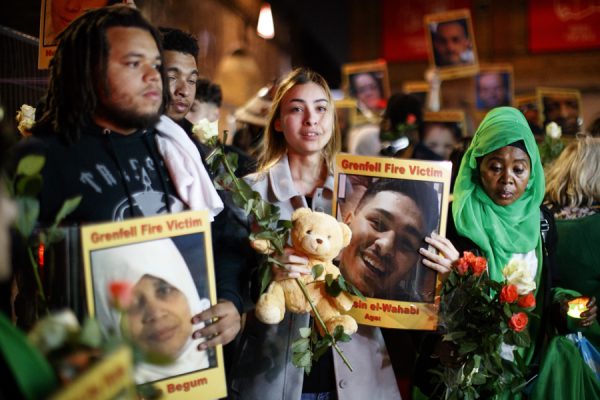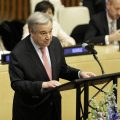
The UK government’s public inquiry into the Grenfell Tower fire paused for a week as a series of memorials and vigils were held one year on from the tragedy.
Thursday marked 12 months since a blaze that authorities believe was started accidentally by a faulty fridge-freezer in the west London high-rise turned into the most deadly domestic blaze since World War II.
Members of the grieving north Kensington community came together for a 24-hour vigil on the eve of the anniversary, to reflect on the 72 people who died.
At 1:30 am, the names of the victims were read out at St Clements’ church. On the anniversary at midday, survivors and the bereaved gathered close to the tower’s base to observe a minute’s silence.
A community mosaic was unveiled, while wreaths were laid and candles lit. The tower is now covered by white sheeting, with banners featuring the green Grenfell heart and the words “Grenfell forever in our hearts” emblazoned across the four highest floors.
The vigil is part of a series of events that included a nationwide one-minute silence at noon on Thursday.
Ahead of the memorials, the vicar of a church that became a focal point for survivors, Father Alan Everett, told The Guardian newspaper the local community had been “dreading this week. The anniversary has stirred things up for many people. None of us quite knows how we’ll feel. There’s been some discussion about re-traumatisation”.
Anger and impatience for justice mix with raw grief in the west London community and many voiced frustration with politicians and the fire brigade ahead of Thursday’s commemorations.
“I don’t understand why as a country we’re not in uproar, why we’re not absolutely telling the government that things need to change now,” said Tasha Brade, a local resident and campaigner with Justice4Grenfell, a support group for survivors.
Campaigners want arrests from an ongoing investigation, as well as a ban on the cladding that helped spread the blaze.
They have criticized the fire brigade’s “stay put” policy for tower residents, which was only lifted after two hours.
The slow effort to rehouse people has added to the anger, with 43 of the 203 displaced households still living in hotels.
“People who were affected did not receive the services they needed with respect to their health and well-being,” said Vassiliki Stavrou-Lorraine, who has lived opposite the tower for 34 years.
“Unfortunately, one year on we are still having this situation.”
The council in Kensington and Chelsea, where Grenfell Tower is located, has been in the spotlight for its role in both the run-up to and aftermath of the fire.
Residents argue the wealthy borough neglected the less affluent northern section that is home to Grenfell and surrounding public housing.
They also accuse it of cost-cutting on the refurbishment and bungling its overall response.
A council spokesman said it had committed 235 million pounds ($315 million) to secure new homes for people to choose from.
Prime Minister Theresa May has also faced criticism, including over her government’s hesitation to ban the cladding involved, after a report said that alone would not stop a repeat of the tragedy.
She apologized on Monday in a newspaper article for only meeting members of the emergency services and not residents when visiting the still-smouldering tower last June.


